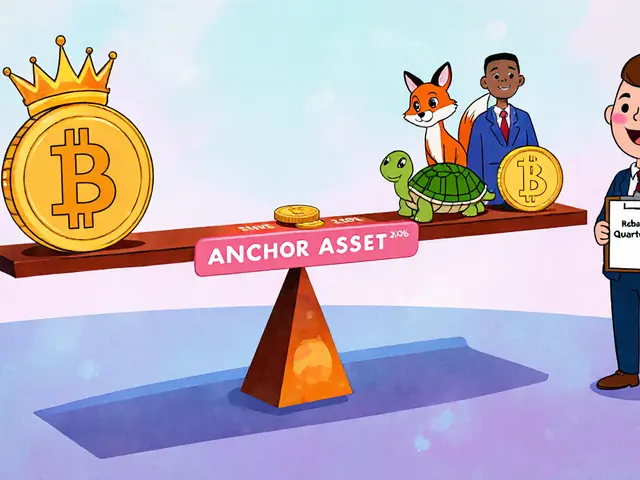Russia Crypto Qualification Calculator
This calculator determines if you qualify as a "highly qualified investor" under Russia's 2025 crypto regulations. To qualify, you must meet one of these criteria:
- Option 1: Own at least 100 million rubles (≈ $1.1 million) in crypto-compatible assets
- Option 2: Earn over 50 million rubles (≈ $550k) annually
Your Qualification Status
Enter your information to see if you qualify as a "highly qualified investor" under Russian regulations.
Since the war in Ukraine, Russian citizens have watched the crypto world shrink around them, turning once‑easy trading into a maze of legal hurdles and technical work‑arounds. This article untangles the current maze, showing exactly what the crypto exchange restrictions Russia look like in 2025, who can still trade, and which shortcuts carry the biggest risks.
Legal backdrop: from “legal but useless” to a dual‑track system
In July2020 Russia passed Law No.259‑FZ - a law that officially legalized owning cryptocurrency but barred its use as a payment method inside the country. The rule took effect in January2021, creating the core premise that Russians can hold digital assets, yet they cannot spend them domestically.
Western sanctions after February2022 forced Moscow to look for alternative ways to move money abroad. The answer arrived in summer2023 with the Experimental Legal Regime (ELR). ELR lets a handful of vetted firms use crypto strictly for foreign‑trade settlements, while the retail market remained under a growing “iron curtain” of prohibitions.
Who the regulators are and what they demand
The Central Bank of Russia (CBR) and the Bank of Russia act as the gatekeepers. Their recent guidance (May2025) mandates that any financial institution keep crypto exposure below 1% of its capital and apply strict risk‑measurement rules.
Most importantly, the CBR has defined a narrow “highly qualified investor” class. To qualify, a person must own at least 100million rubles (≈$1.1million) in crypto‑compatible assets or earn over 50million rubles (≈$550k) annually. Only these investors can open a crypto‑enabled account with a licensed bank.
On the AML front, the regulator requires all crypto‑related services to implement real‑time transaction monitoring, enhanced customer‑due‑diligence, and mandatory reporting of any suspicious P2P trades. Failure to comply can lead to fines up to 5% of annual turnover and, for individuals, possible criminal charges.

Everyday impact: why ordinary Russians hit a wall
For the typical citizen, the practical consequences are stark:
- Identity verification now demands a non‑Russian passport or a foreign proof‑of‑address - a hurdle for many who only have Russian IDs.
- Bank accounts linked to crypto activity may be frozen after as few as three small‑scale P2P trades, according to a June2023 CBR warning.
- Major global exchanges (Coinbase, Binance, Kraken) have either blocked Russian IPs or limited withdrawal limits to €10,000 per year.
Reddit’s r/CryptoRussia forum shows over 40000 members sharing screenshots of frozen accounts and denied KYC requests. A September2025 thread titled “Binance verification nightmare” amassed 287 comments describing the new proof‑of‑address requirement.
Common work‑arounds and the risks they bring
Despite the clampdown, many users still find ways to move crypto:
- Using a VPN or proxy to mask a Russian IP address and reach offshore exchanges.
- Opening accounts on offshore exchanges that accept foreign documents.
- Trading on P2P platforms such as LocalBitcoins and Paxful, where fiat is transferred via bank wires, cash‑in‑person, or gift cards.
Each shortcut carries a price:
- VPN use is legal, but many exchanges flag and block accounts that suddenly switch locations.
- Offshore exchanges often have weaker AML controls, increasing exposure to fraud and loss.
- P2P trades are unregulated, prone to scams, and can trigger bank account blocks if the CBR detects repeated crypto‑related transfers.
Side‑by‑side look: Russia versus the US and EU
| Aspect | Russia | United States | European Union (MiCA) |
|---|---|---|---|
| Legal status of ownership | Legal but cannot be used for payments | Legal, treated as property | Legal, classified as asset class |
| Retail access | Restricted to "highly qualified investors" only | Open to all, subject to AML/KYC | Open to all with licensing for service providers |
| Exchange licensing | No domestic licensed exchanges | SEC/CDSC registration required for certain activities | MiCA licensing mandatory for crypto‑asset service providers |
| Sanctions handling | ELR permits crypto for sanctioned trade | OFAC sanctions block most Russian entities | EU 19th Sanctions Package targets "dirty Russian crypto" |
| Typical user‑level risk | High - account freeze, legal ambiguity | Moderate - standard AML compliance | Low‑moderate - clear regulatory framework |
The table makes it clear: Russia has deliberately built a bifurcated system that excludes the masses while allowing a privileged few to operate under the ELR.

Recent shifts: a slight easing or a new tightening?
On 10October2025, First Deputy Governor Vladimir Chistyukhin
Simultaneously, the Finance Ministry floated a proposal to lower the “highly qualified investor” threshold, though no concrete numbers have been published. Analysts suspect the move aims to attract more capital without opening the floodgates to retail users.
The EU’s 19th Sanctions Package, released in September2025, specifically targets “dirty Russian crypto” schemes, forcing Russian actors to adopt more sophisticated laundering techniques. This external pressure adds another layer of complexity for anyone trying to move crypto out of the country.
Practical checklist for Russian citizens
If you still want to dabble in crypto despite the hurdles, follow this step‑by‑step guide:
- Assess eligibility: Do you meet the 100million‑ruble asset or 50million‑ruble income threshold? If not, you fall into the restricted category.
- Choose an access method:
- VPN + offshore exchange (e.g., Binance, Kraken) - requires foreign ID.
- P2P platform - require a trusted counter‑party and small transaction volume to avoid bank flags.
- Complete enhanced KYC: Prepare a passport from another country, utility bill, or bank statement that shows a non‑Russian address.
- Set up a secure wallet: Hardware wallets (Ledger, Trezor) keep your private keys offline and reduce exchange exposure.
- Plan fiat on‑ramps/off‑ramps: Use reputable peer‑to‑peer escrow services or foreign bank accounts; avoid frequent small transfers that could trigger CBR monitoring.
- Stay compliant: Keep transaction logs, monitor for any CBR alerts, and be ready to explain crypto activity if your bank contacts you.
Even with this checklist, remember that the landscape can shift overnight - keep an eye on official CBR releases and reputable news outlets.
Frequently Asked Questions
Can an average Russian open an account on Binance or Coinbase?
Most global exchanges now block Russian IPs or require a foreign address. Without a non‑Russian passport or proof‑of‑address, the account will be denied or frozen.
What is the “Experimental Legal Regime” and who can use it?
ELR is a government‑approved framework that lets selected companies settle foreign‑trade invoices with crypto. It does not apply to private individuals unless they are classified as highly qualified investors.
If I use a VPN, am I breaking the law?
Using a VPN is legal in Russia, but accessing a blocked exchange may violate that exchange’s terms of service and could trigger account closure.
Are P2P platforms safer than offshore exchanges?
P2P avoids centralized custody, but it lacks regulatory protection. Scams, price manipulation, and bank‑account blocks remain common risks.
Will the upcoming CBR amendment allow regular citizens to trade crypto?
The October2025 amendment only relaxes capital limits for banks; it does not change the highly qualified investor threshold, so ordinary retail access stays restricted.






Millsaps Crista
Wow, that breakdown really shines a light on how tight the Russian crypto rules have become. If you're thinking about diving in, make sure you have a solid backup plan. The calculator they included is a handy first step, but don’t rely on it alone. Keep your docs ready and stay ahead of the compliance curve.
Matthew Homewood
It’s fascinating how regulatory frameworks shape market behavior. The distinction between “legal but useless” and “highly qualified” creates a new class of financial actors. One could argue it mirrors historical asset class stratifications. The long‑term effects on innovation remain an open question.
Shane Lunan
VPNs are a quick fix but they get flagged fast.
Maria Rita
Reading this, I feel for anyone stuck between wanting to invest and facing these hurdles. The requirement of a foreign passport feels like a gatekeeper for the privileged. Still, the detailed table helps visualize where Russia stands against the US and EU. Stay informed and consider the risks before you jump.
Jordann Vierii
Hey folks, if you’re looking for a workaround, check out the upcoming offshore exchange webinars. They often walk you through the KYC alternatives and how to keep your assets safe. Energy and optimism can go a long way when navigating this maze.
Lesley DeBow
The paradox of “legal but unusable” reminds me of ancient barter systems-only the elite could truly trade. It’s a modern twist on wealth concentration, don’t you think? :)
Russel Sayson
Russia’s 2025 crypto regulation landscape is a textbook example of selective liberalization. By defining “highly qualified investors” with a 100 million‑ruble asset threshold or a 50 million‑ruble annual income, the state effectively bars the average citizen from participating in the market. This dual‑track approach mirrors the historical separation of “privileged” and “mass” financial services seen in other jurisdictions. The Central Bank’s mandate that crypto exposure stay under one percent of an institution’s capital further tightens the noose on liquidity. Consequently, domestic banks are reluctant to offer crypto‑related products, pushing users toward offshore platforms. While the Experimental Legal Regime (ELR) offers a narrow gateway for sanctioned trade, it is limited to a handful of vetted firms, leaving the broader population in limbo. Real‑time transaction monitoring and enhanced due‑diligence requirements raise operational costs, which are ultimately passed on to consumers. The risk of account freezes after just a few peer‑to‑peer trades creates a chilling effect, discouraging even modest crypto activity. Global exchanges responding to sanctions have instituted withdrawal caps, often as low as €10,000 per year, squeezing out Russian users further. The practical impact is a fragmented ecosystem where users juggle VPNs, offshore accounts, and risky P2P platforms to stay afloat. Each workaround introduces its own vulnerabilities: VPNs can trigger automated bans, offshore exchanges may lack robust AML safeguards, and P2P trades are fertile ground for scams. Moreover, the legal ambiguity surrounding “highly qualified” status fuels uncertainty, as the criteria can be interpreted variably across jurisdictions. Investors who do meet the thresholds face heightened scrutiny and potential criminal charges for non‑compliance. In contrast, the United States and the EU maintain broader retail access, albeit with strict AML/KYC protocols, highlighting the divergence in regulatory philosophy. Ultimately, the Russian model serves both as a control mechanism and a catalyst for underground activity, reshaping the crypto landscape in ways that professionals must monitor closely.
Isabelle Graf
So the government decided that only the ultra‑rich get to play with Bitcoin-how original.
Scott G
Thank you for the comprehensive overview. Your analysis of the systemic implications is both thorough and insightful. It is evident that the regulatory bifurcation will have lasting effects on market dynamics. I appreciate the balanced perspective you provided.
VEL MURUGAN
While your sarcasm captures a sentiment, the factual basis requires scrutiny. The data indicates that the asset thresholds are not arbitrary but stem from fiscal risk assessments. Dismissing them as merely “original” overlooks the broader macro‑economic context.
Mitch Graci
Oh great, another “elite‑only” crypto rule-because Russia clearly needs more *privilege*!!! 🙄🙄🙄
Jazmin Duthie
Sure, because adding sarcasm solves regulatory hurdles.
Michael Grima
Yeah, totally realistic.
DeAnna Greenhaw
One must acknowledge the poetic tragedy inherent in a system that simultaneously legalizes and enslaves. The juxtaposition of legality with prohibitive access engenders a paradox that scholars will dissect for years. It is not merely a policy decision but a cultural statement about wealth and power. As such, the discourse transcends economics, entering the realm of societal philosophy. Let us, therefore, observe with scholarly rigor the unfolding narrative.
Luke L
Your lofty prose ignores the stark reality that these rules protect national interests. Instead of romanticizing the tragedy, recognize that restricting crypto keeps our economy stable. The elite rhetoric distracts from the practical need for sovereignty.
Cynthia Chiang
I see where you’re coming from, and while the regulations feel harsh, we can still find ways to help each other navigate safely. Sharing reliable resources and community support can mitigate some of the stress.